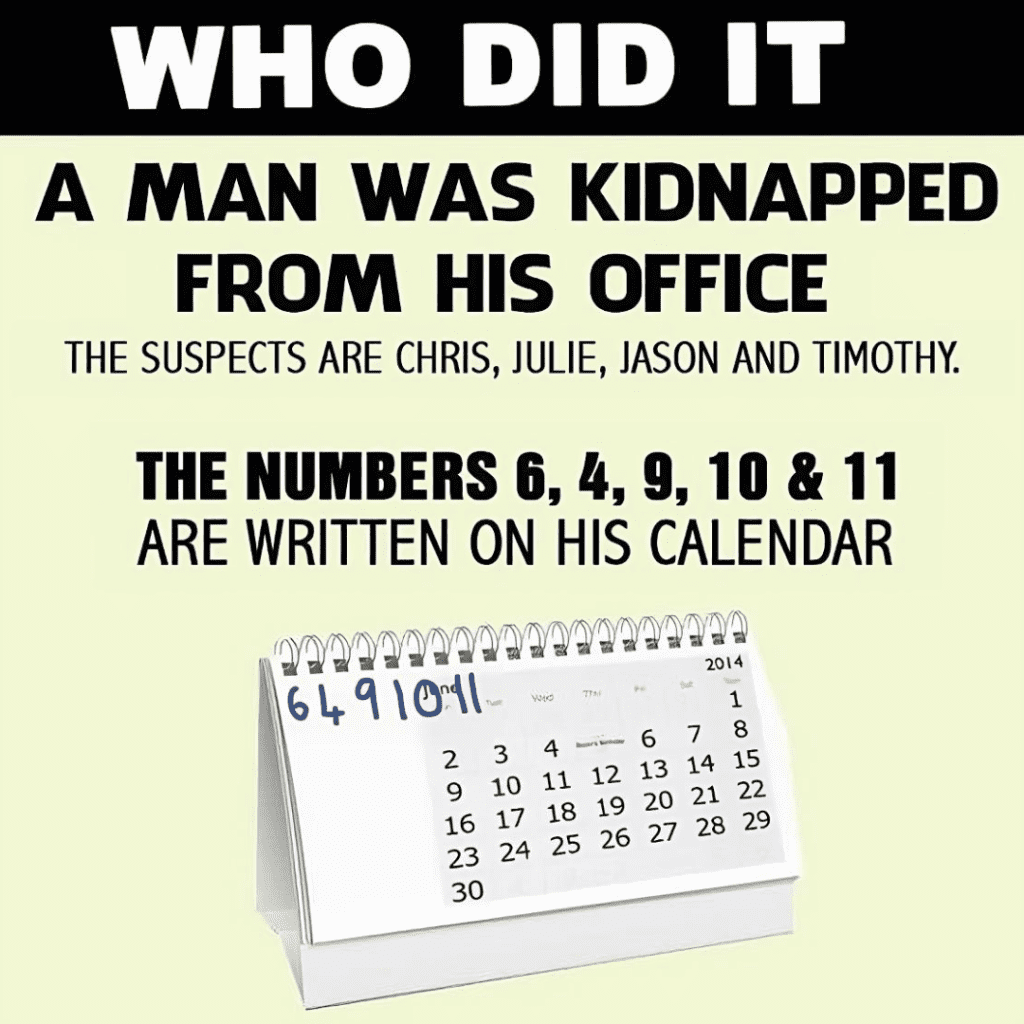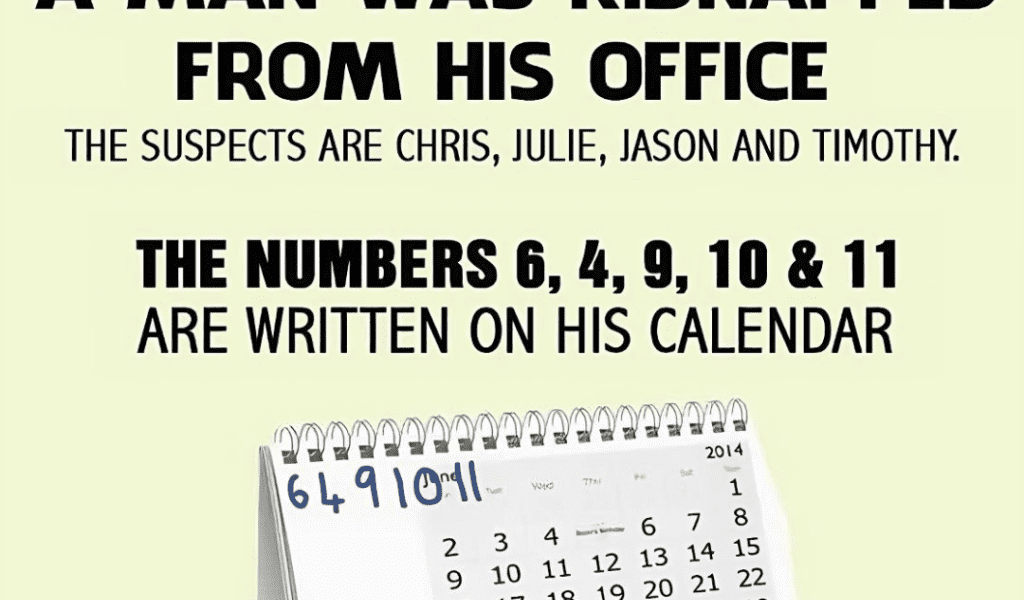Puzzles are not just entertaining—they’re also a fantastic way to hone your critical thinking, logic, and reasoning skills. Today, we delve into an intriguing puzzle: “Who Did It?” In this scenario, a man is kidnapped from his office, and you have four suspects to choose from: Chris, Julie, Jason, and Timothy. On the victim’s calendar, you find five mysterious numbers written down: 6, 4, 9, 10, and 11. These numbers hold the key to identifying the kidnapper. But how do they connect to the suspects? Let’s solve this mind-bending puzzle together.
Understanding the Puzzle’s Core Elements

The puzzle presents two key elements: four suspects and five numbers written on a calendar. At first glance, it might seem that these numbers could represent dates, times, or an event sequence. However, this straightforward approach doesn’t solve the mystery. Instead, these numbers are a cleverly disguised code meant to lead you directly to the kidnapper.
Common Mistakes Solvers Make
When approaching a puzzle like this, it’s easy to get sidetracked. Here are some typical mistakes that prevent people from finding the correct solution:
1. Overthinking the Numbers:
Many solvers assume the numbers represent dates, times, or a complex code. While this makes sense initially, it leads you down the wrong path.
2. Ignoring Contextual Clues:
The puzzle involves suspects, a calendar, and numbers. Solvers often fail to consider how these elements work together, especially the connection between the calendar months and the numbers.
3. Missing the Pattern:
The numbers form a pattern when linked to specific months of the year. However, failing to see that these months correspond to letters spelling out a name is a common oversight.
Step-by-Step Solution: Unveiling the Kidnapper
Now, let’s break down the puzzle using the given information. The numbers written on the calendar—6, 4, 9, 10, and 11—hold the clues needed to identify the kidnapper.
Step 1: Connect the Numbers to Calendar Months
The first realization is that the numbers don’t represent days or times; they signify months of the year. Here’s how the numbers translate into months:
- 6 represents June
- 4 represents April
- 9 represents September
- 10 represents October
- 11 represents November
Step 2: Extract the First Letters of Each Month
Next, focus on the first letter of each identified month:
- June gives us J
- April gives us A
- September gives us S
- October gives us O
- November gives us N
Step 3: Forming the Name of the Kidnapper
When you put these letters together, they spell out JASON. This means that Jason is the kidnapper in this puzzle. It’s a simple yet clever use of letters and numbers that demands both attention to detail and a shift in perspective.
Why Small Details Matter

This puzzle emphasizes the importance of small details in problem-solving. Let’s explore how these details guide you toward the solution:
1. Dual Purpose of Numbers:
The numbers serve two functions. First, they represent months on a calendar, and second, they act as a code to spell out the kidnapper’s name. Recognizing this dual purpose is crucial to solving the puzzle correctly.
2. The Power of Contextual Clues:
This puzzle teaches you that context matters. Instead of getting lost in complex codes, understanding that the numbers represent months is the key to unlocking the solution.
3. Simplicity Over Complexity:
While the puzzle may initially appear complex, its solution is elegantly simple. It’s a perfect reminder that complex problems often have straightforward solutions when viewed from the right perspective.
Why Puzzles Are Beneficial for Your Brain
Puzzles like this one do more than just entertain—they offer numerous mental benefits:
1. Boosts Problem-Solving Skills:
Engaging with puzzles improves your ability to solve real-life problems. You learn to break down complex information, identify patterns, and come up with creative solutions.
2. Enhances Memory and Focus:
Puzzles require you to remember details and maintain focus. This regular mental exercise can improve your short-term memory and concentration over time.
3. Fosters Patience and Persistence:
Solving puzzles requires patience. You learn to persist even when the solution isn’t immediately clear, cultivating a sense of determination.
Conclusion: A Puzzle Worth Solving
Did you figure out the puzzle on your own, or did the explanation help? Whether you got it right away or needed a nudge, the real takeaway is the journey of solving it. Puzzles like this one challenge your brain to think differently, encouraging you to explore creative solutions and develop a sharper mind.
If you enjoyed unraveling this mystery, why stop here? There are countless other puzzles out there waiting to test your logic, reasoning, and creativity. So, keep exploring, keep thinking, and most importantly—keep having fun with puzzles!




